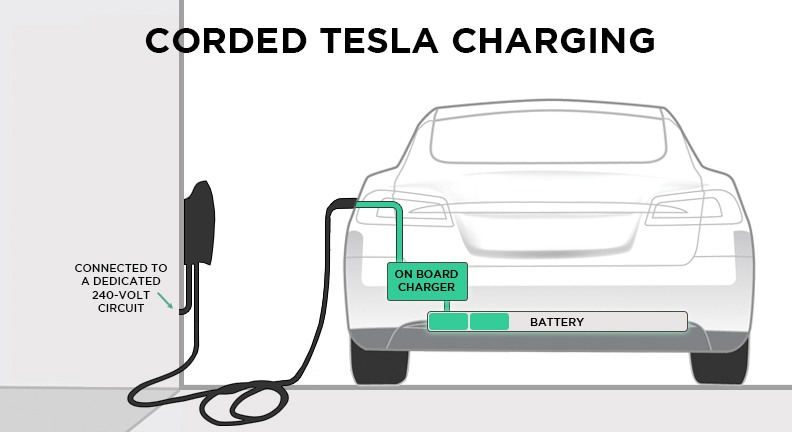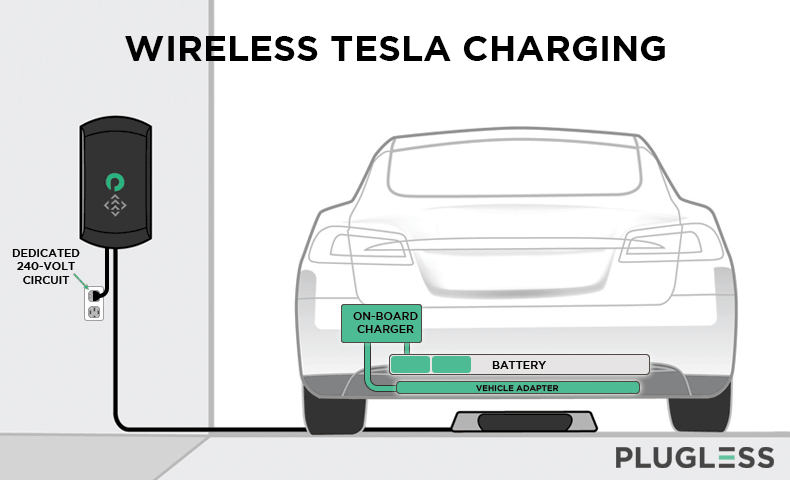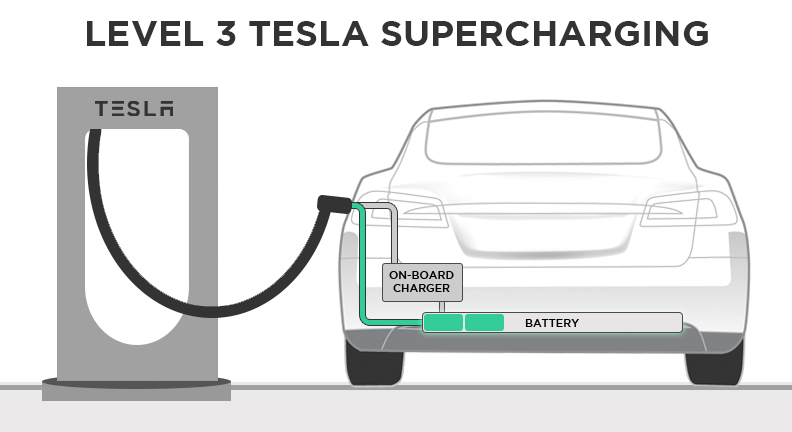TESLA CHARGING: THE COMPLETE GUIDE TO CHARGING AT HOME, IN PUBLIC AND AUTONOMOUSLY
Tesla Charging Basics: What to Know & Why You Care
Each level of charging delivers different charging speeds. Different Tesla configurations have a maximum charge power they can accept. Choosing the right Tesla charger minimizes hassle and installation costs. And maximizes your enjoyment of electric driving. Keep reading to make charging levels as easy as 1, 2, 3.
First, an “EV Charger” Can Refer to Two Different Things
- Internal or “On-Board” Charger
The on-board charger is a component inside the car. The OBC manages internal power flow to safely charge your EV battery. - External Charger or “EVSE”
The box-and-cord device has a technical name. “Electric vehicle supply equipment,” or EVSE. The EVSE delivers power from the grid (or other source like solar panels) to your EV’s on-board charger in the first place. Still, everyone tends to call the EVSE a “charger.” So will I for the rest of this post.
EVSE = “Charger” In This Post

How Fast Can I Charge?
Depends on the charging level, the maximum power output of the charging station and max power intake of your EV. There are 3 levels of chargers:
- Level 1 (120 volt) charging
- Level 2 (240 volt) charging
- Level 3 (480 volt) Supercharging or DC fast charging

What ARE Charging Levels, Exactly?
Levels 1, 2, and 3 chargers run on different levels of voltage.

Think of electricity like water flowing through a pipe. Higher current (Amps) flowing through larger pipes (Volts) means a faster battery “fill-up.” Ya dig?

Now let’s run through the topline information on all three levels of charging.
Why Is Level 1 Tesla Charging Called “Trickle Charging”?
Tesla owners can in fact charge via a standard 120V residential outlet with a trickle charging adapter. It’s nicknamed “trickle” charging because it’s really, really slow.
THE GOOD
- No Upfront Cost. A new Tesla owner gets the 110/120V adapter for plugging into a regular ol’ home outlet at no additional charge.
- Charge virtually anywhere. Standard outlets are super easy to come by. Convenient.
THE BAD
- Snail status. Most Tesla owners say that trickle charging “doesn’t cut it.” It will take all night to recoup 48 kms’ worth of range.
- Missing “time of use” discounts costs $$. Many electric utilities offer discounts when the grid would otherwise be idle. Usually in the middle of the night.
Why Level 2 Is Best for Home Charging
240V level 2 chargers provide a bigger “pipeline” for electricity to flow to your Tesla. They can charge up to 15 times faster than trickle chargers. Tesla Mobile Connector, Wall Connector and the wireless Tesla charging station are different types of Level 2 chargers.
Level 2 is the level for you if any of these things are true:
- You don’t want to (or can’t) rely heavily on Supercharging stations
- Your electric utility offers time of use (TOU) discounts for nighttime charging
- You want to use the self-charging upgrade
- You really want to enjoy driving the heck out of your Tesla
3 Factors that Determine Level 2 Charging Speed for your Tesla
A “Level 2” EV charger is simply any EV charger that can connect to a particular type of electrical circuit — 240 volt, split phase circuits (similar to what an electric dryer uses). But just like different clothes dryer models take different amounts of time to dry your clothes, different EV chargers take different amounts of time to charge your car.
What determines the speed of Level 2 Tesla charging are the following factors:
- Maximum power output of the charger: Different chargers pull different amounts of electrical current through the 240 v electrical circuit. More current = more power = faster charge. Level 2 chargers deliver anywhere from 3.3 – 17.2 kW of power enabling 16-83 kms of range per hour charging.
- Maximum power intake of your Tesla: This is either 17.2 kW or 11.5 kW depending on which variant you own.
- All Model S variants come standard with 11.5 kW charging to for a maximum of 51 kms of range per hour charging.
- Model S variants with the “High Amperage Charger” option can accept up to 17.2 kW of power for a maximum 83 miles of range per hour.
- Maximum current capacity of your electrical panel – Your home’s electrical panel can likely withstand the draw of either 100 or 200 amps of electrical current. Charging at 17.2 kW of power on a 240 volt circuit may require a home electrical panel upgrade to 400-amp service. Read more about amperage requirements for Level 2 EV charger installation.
How Fast is Fast Enough for Home Tesla Charging?
As long as you’re charging at home, you’re charging the way Tesla recommends is best. It doesn’t push your battery with incredibly high charging speeds and it takes advantage of time when your car is parked at night anyway.
The ideal home Tesla charger offers these benefits:
- Recoups your daily driving range in just a few hours
- Fully recharges your battery overnight on the occasions that you arrive home on low charge (after a long trip, etc)
- Doesn’t require major upgrades to your home electrical service
For drivers who cover about 59 kms per day on average, a charger that delivers 32-48 kms of range per hour charged is ideal (6.6-10 kW power delivery). Average daily miles are recharged within 2 hours and even a close-to-empty 100 kWh battery can be charged fully overnight. For the vast majority of homes, charging at those speeds will not require major electrical service upgrades to 400 amps. Tesla drivers don’t need to worry about forgetting to charge. In a pinch, there are Superchargers. And Plug less offer an automatic, wireless charging upgrade for home Tesla charging (see below).
How Your Tesla Can Charge Autonomously
- Plug-in charging requires the driver to manually connect and disconnect the vehicle from outlet for each charging session (and to remember to do so).
- Plugless charging upgrade enables your Tesla to charge itself simply by being parked over its wireless charging pad. A Vehicle Adapter receives the energy and charges your battery. Plugless for Model S is available now, with eventual support planned for Model X and of course Model 3 –get updates here.

Plug-in and Plugless chargers both deliver AC power the to Model S’ internal on-board charger. Model S can’t tell the difference between being plug-in or Plugless charging. See the video explanation to learn more.
Tesla Supercharging Speeds

Level 3 Superchargers can take a Tesla from 0-272 range in just 30 minutes. It can get to 80% full in just 40 minutes. At the 80% point, charging slows to safeguard battery health. And there are lots of them. View an interactive Supercharging map at tesla.com/supercharger. The Tesla Supercharger map is also conveniently built in to the Tesla navigation system on the 17″ touch screen control panel. Convenient road trip charging is literally at your fingertips.
